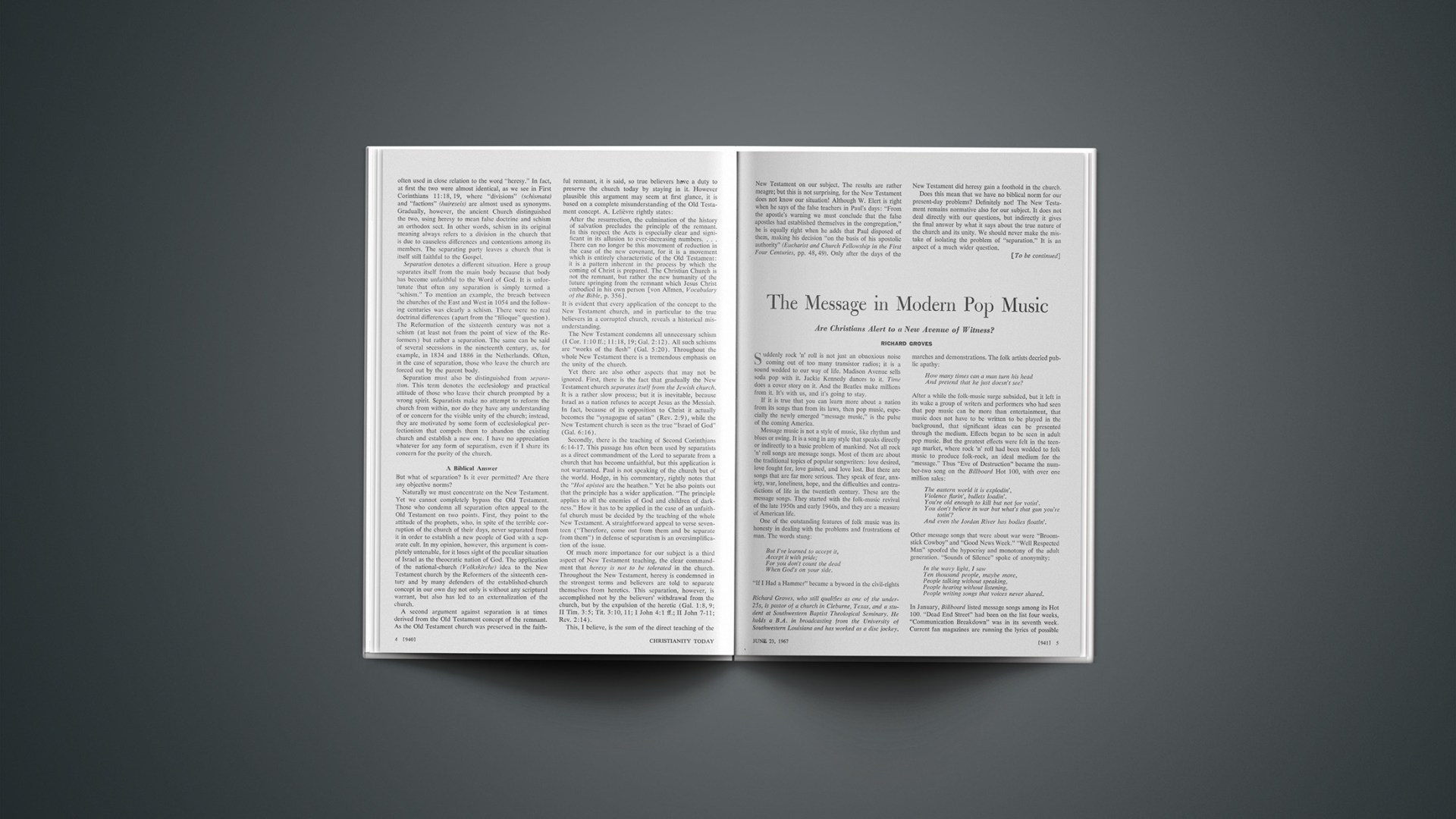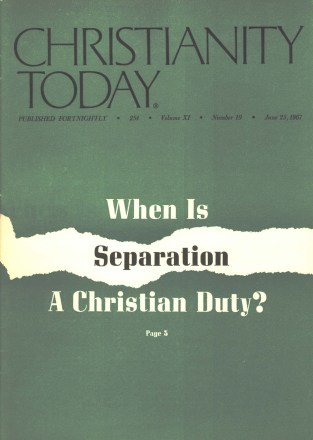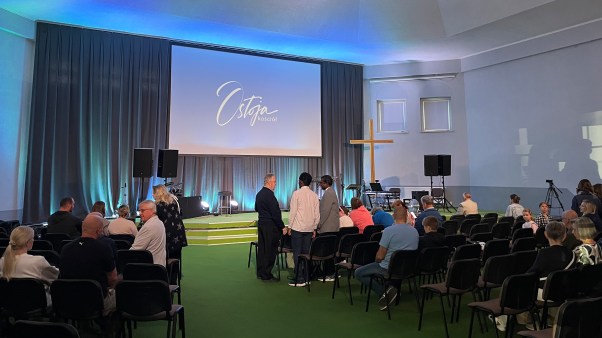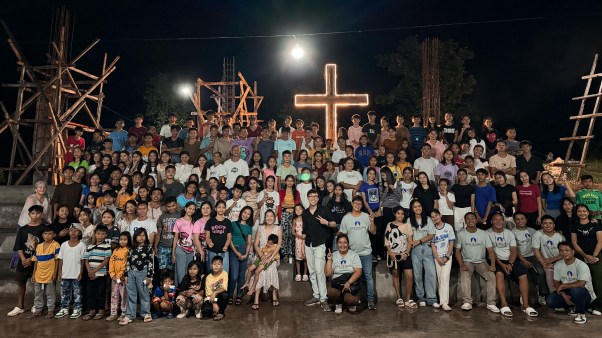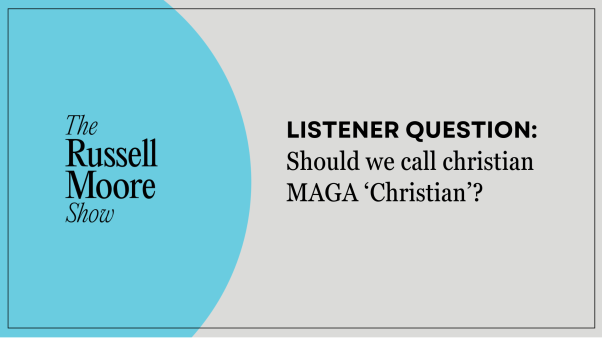Are Christians Alert to a New Avenue of Witness?
Suddenly rock ’n’ roll is not just an obnoxious noise coming out of too many transistor radios; it is a sound wedded to our way of life. Madison Avenue sells soda pop with it. Jackie Kennedy dances to it. Time does a cover story on it. And the Beatles make millions from it. It’s with us, and it’s going to stay.
If it is true that you can learn more about a nation from its songs than from its laws, then pop music, especially the newly emerged “message music,” is the pulse of the coming America.
Message music is not a style of music, like rhythm and blues or swing. It is a song in any style that speaks directly or indirectly to a basic problem of mankind. Not all rock ’n’ roll songs are message songs. Most of them are about the traditional topics of popular songwriters: love desired, love fought for, love gained, and love lost. But there are songs that are far more serious. They speak of fear, anxiety, war, loneliness, hope, and the difficulties and contradictions of life in the twentieth century. These are the message songs. They started with the folk-music revival of the late 1950s and early 1960s, and they are a measure of American life.
One of the outstanding features of folk music was its honesty in dealing with the problems and frustrations of man. The words stung:
But I’ve learned to accept it,
Accept it with pride;
For you don’t count the dead
When God’s on your side.
“If I Had a Hammer” became a byword in the civil-rights marches and demonstrations. The folk artists decried public apathy:
How many times can a man turn his head
And pretend that he just doesn’t see?
After a while the folk-music surge subsided, but it left in its wake a group of writers and performers who had seen that pop music can be more than entertainment, that music does not have to be written to be played in the background, that significant ideas can be presented through the medium. Effects began to be seen in adult pop music. But the greatest effects were felt in the teen-age market, where rock ’n’ roll had been wedded to folk music to produce folk-rock, an ideal medium for the “message.” Thus “Eve of Destruction” became the number-two song on the Billboard Hot 100, with over one million sales:
The eastern world it is explodin’,
Violence flarin’, bullets loadin’.
You’re old enough to kill but not for votin’.
You don’t believe in war but what’s that gun you’re totin’?
And even the Jordan River has bodies floatin’.
Other message songs that were about war were “Broomstick Cowboy” and “Good News Week.” “Well Respected Man” spoofed the hypocrisy and monotony of the adult generation. “Sounds of Silence” spoke of anonymity:
In the wavy light, I saw
Ten thousand people, maybe more,
People talking without speaking,
People hearing without listening,
People writing songs that voices never shared.
In January, Billboard listed message songs among its Hot 100. “Dead End Street” had been on the list four weeks, “Communication Breakdown” was in its seventh week. Current fan magazines are running the lyrics of possible future hits: “Who Am I?,” “A Hazy Shade of Winter,” “Behind the Door” (“To bare and die, the years go by / To wed in spring, the funeral tier / And still they go a-mating.”), “Going Nowhere” (“This world will not be happy / Until they see everybody going nowhere”).
Frustrations, longings, inherited problems too difficult to master—these provide the subject matter for many of the current message songs. Songwriters like Barry Mann and Cynthia Weill, Sonny Bono, and Pete Simon and Art Garfunkel are speaking to the sensitive areas of modern man’s existence: They lay bare hypocrisy, hidden fears, the doubts and inadequacies of our generation; they reveal the difficulties of living when the “times they are a-changin’.”
Many adults wonder how teen-agers are related to the music they listen to and sometimes argue that the “messages” are not really an adequate expression of the feelings and beliefs of young people. There does seem to be, however, some correspondence between the “messages,” a minority of popular songs, and the actions of a minority of the teen-age population. For example, during the time when many college students were participating in civil-rights marches, “If I Had a Hammer” and “Blowin’ in the Wind” were high on the record charts. While students demonstrated against the Viet Nam war, their transistors blared “Eve of Destruction,” “Broomstick Cowboy,” and “Good News Week.”
At the same time it must be remembered that the value of a work of art, or of a prophet, is not to be determined by the degree to which it represents the consensus. Amos did not represent the feelings and beliefs of his time, but his insights were nonetheless true. In fact, it is this feature that should cause us to ask, “What is being said to our young people?” “Who are the people who plant seeds in the minds of our teen-agers?” This question alone should cause us to listen to the “caterwauling” that forms such an important part of the young person’s milieu.
What value and possibilities does “message music” have? First, much of the message music of the past five years has forced the modern youth to look critically at himself and his world. It has stripped him of the veneer of self-righteousness. This is the negative witness that can lead to real concern and honest self-evaluation. Second, message music has, to a lesser extent, served in a positive way. For example, “Kicks,” by Barry Mann and Cynthia Weill, received an award from Synanon for criticizing the use of dope among teen-agers. Third, message music opens a new avenue of witness for the evangelical church. Great care should be taken in making use of this, of course, but making music that is both commercial and thought-provoking from the Christian point of view is possible. If it is done, the message should not be so obvious as to be offensive, nor so veiled that it is not communicated.
All this must sound strange to those of us dedicated to a pulpit ministry. Yet the Gospel must be communicated. If it is hidden, it is hidden to those who are lost (2 Cor. 4:3). If seeds can be planted on a “Top 40” show, then so be it. Unorthodox? Certainly. So were a prophet wearing a yoke and a child named Loammi.

